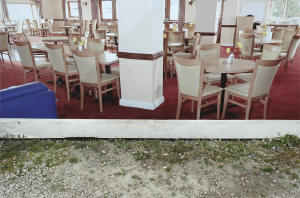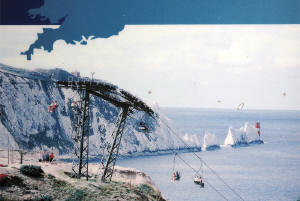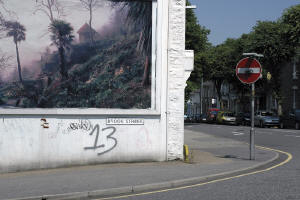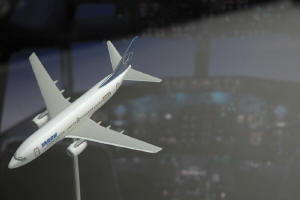| artcornwall | |||
| home | features | exhibitions | interviews | profiles | gazetteer | links | archive | forum | |||
|
Distance and distraction A personal reflection on photography, travel and the future Matthew Pontin
I find myself at
Waterloo train station. Sitting comfortably inside coach one, on seat
fifty-one, I notice through the train window a young couple approach a
solitary traveller and ask if he will take their photograph. He slowly
lowers his bag onto the platform, accepts the camera handed to him and
frames the image capturing the couple, smiling and facing forward, with
the scene that is the 9.04am Eurostar to Paris as the backdrop. Having
just witnessed the birth of this photograph I begin to imagine the journey
it will make, contemplating the eyes that may one-day view it and
considering what value will it hold in the future. Like the engraved
confirmations of presence left behind in Bruges, the image of the young
couple announces ‘I was Here’. Which leaves me wondering what kind
of photograph allows us to separate the idea of
memory from the idea of permanence.
Marc Augé expressed the impossibility of describing and seeing everything in a place, a sensation which often results in the feeling of disorientation and the need to take photographs; “this is me in front of the Parthenon, you will say later, forgetting that when the photo was taken you were wondering what on earth you were doing there” (Augé, 1995, 84). The photograph facilitates memory, frees it from the moment that was interrupted by the uncertainties of actual experience, providing the future with a past. The archiving and cataloguing of our own personal histories is stimulated by the photograph; Augé positions this desire for constant documentation within an era where “history is on our heels, following us like our shadows, like death” (Augé, 1995, 26). I recently found myself revisiting a website offering digital prints and other photographic services. On arriving at this site I was greeted with a bold message, placed over an image of a couple obscuring the faces of the individuals, warning “Memories at Risk! A real photo will keep them forever. Click here for more info...” (Snappy Snaps, 2005) In a world mediated for expedient consumption, are memories not rather at risk from real photographs? Within our already overloaded visual environment, the greater risk is conceivably that photography is passively providing yet more representations of reality, even more distractions. Why photograph travel experiences? I am questioning travel and photography as contemporary means of signifying existence and begin to understand an illusory relationship that contributes to the atrophy of actual experience. “For the twentieth-century tourist, the world has become one large department store of countrysides and cities” (Schivelbusch, 1986, 197). Distance becomes the essential component in justifying a travel experience, a trend of modern exploration assisted by inexpensive air-travel. “If there was a top ten list featuring the ‘perks’ of twenty-first century living, the no-frills-low-cost flight would be a strong contender for the top spot” (Siegle, 2005). This new hypermobility (Adams, 1999) has environmental consequences that shouldn’t be ignored as they presently appear to be, take one example; there are 300,000 passengers in flight over the US at any given moment, the equivalent of a significant sized city, and the most basic of Newton’s theories would simply reveal that keeping a city airborne continuously may be adding to a carbon emissions problem.
This idea of non-travel became a focus of my research after reading Joris-Karl Huysmans’ Against Nature, an extravagant account based around the misanthropic Duc des Esseintes, who elaborately employs illusions to stimulate the imagination into taking flight and disappearing on a journey. “Travel, indeed, struck him as being a waste of time, since he believed that the imagination could provide a more-than-adequate substitute for the vulgar reality of actual experience.” (Huysmans, 1959, 35) His simulation of the real becomes increasingly complex in satisfying all of his senses, the authenticity of each simulation conducive to fantasising and indicative to his rejection of reality. Huysmans’ text led me to spend several months researching the condition Agoraphobia and from this began a personal journey into the nature of travel experiences. To what extent does place have to be visited to be experienced? The Elizabeth Bishop poem Questions of Travel addresses a similar notion, “is it lack of imagination that makes us come to imagined places, not just to stay at home?” (Bishop, 1991) The idea that we are external to the experience, on the outside, observers, potentially leaving us with a sense of inadequacy that makes one consider “why bother” (Bishop, 1991). Why bother indeed, if the traveller’s way of seeing is now so securely attached to the photograph what need is there to actually visit a place for real. “The camera provided an infallible vantage point on the world. Sensory evidence that depended in any way on the body was rejected in favour of the representation of this mechanical and monocular apparatus, whose authenticity was placed beyond doubt.” (Crary, 1988, 32) Paul Virilio discussed this waning reality and asked, “what kinds of travel and travel photography are possible when the traveller’s old certainties concerning self, art and old qualities and purposes of journeys are being lost?” (cited in Osbourne, 2000, 184) Real, actual lived experience, does provide countless occasions to examine whether experiential authenticity exists. If it does not then the photograph may have the potential to enter the world and be both more and less authentic than actual experiences.
One afternoon during
Spring I turned to look back, before crossing a street, and glanced up at
a bus passing by adorned with a large-scale advert for a holiday
destination. The side of this vehicle revealing the seductive image of a
deserted sandy beach, photographed to ensure that in the foreground were
several chairs and tables resting on a balcony, encouraging my imagination
to enter into the scene and to sit back and relax in the glowing sunshine
with the This disembodied vision leads in the direction of simulation, numerous organisations are developing technology that can provide experiences that are wholly visual and wholly convincing, such emergent technologies within image making are becoming principal frameworks for visualization. Vision that no longer relies upon the observing subject affects the modes of representation we reference and as technology departs its analogue phase new mechanisms appear to potentially awaken emotion and reverie. “Virtual travel draws imagery from and flexibly incorporates all of the fore going strategies of containment of the tourist imagination: decoys, ‘rides’, screen memories and total fabrication. Thus tourism opens the way for the complete incorporation of itself, and whatever residual connection it may have had to ordinary experience, into Virtual Reality.” (MacCannell, 1997, 19)
Harry Pearson,
recently published, Around the World by Mouse in which he writes
about his journeys across cyberspace, perhaps a contemporary Situationist
exploit, he virtually circumnavigated the globe, travelling 600 miles a
day, from the safety of his office; “I experienced the sights and sounds
of the countries I visited through the images on tourist websites,
streaming local radio stations, downloading indigenous music, birdsong,
animal calls and video clips from Philippines soap operas; through live
cams, the weblogs of US Peace Crops
Virtual travel may provide the distance and distraction to stimulate sensations of actual travel yet digital satisfaction surely resides in virtual travel’s ability to successfully accommodate the human desire for retrospection; producing all the retrospective sensations of a real experience. Dean MacCannell points out that virtual reality is only able to provide a backdrop and is always limited by a program, such experiences “are given meaning, they are not free to mean on their own” (MacCannell, 1997) and it is this reduces the ‘realness’ of the simulation. There is also a fear for the mortality of subject and traveller within this mode of exploration, since “if I can arrive without ever having set out, that self-same ‘I’ ceases to exist.” (Pinney, 1994, 424) On this understanding corporeal travel probably won’t disappear altogether, global tourism depends upon physical consumption of place and digital photography has, even more than analogue achieved, given a definitive shape to travel. As we exist now, the eye must have been present, even if trapped behind a viewfinder, for the experience to be deemed significant in real life. Actual travel and “co-presence affords access to the eyes. Eye contact enables the establishment of intimacy and trust, as well as insincerity and fear, power and control. Simmel considers that the eye is a unique ‘sociological achievement’ since looking at one another is what effects the connections and interactions of individuals.” (Frisby & Featherstone, 1997, 111)
The photographs I
currently make are about journeys, revealing a personal vision exploring
the
This is an abridged version of the full essay Matt's own website is at www.visulate.org. He is also a member of CAN (Cornwall Artists Network - see links page)
|
|||




